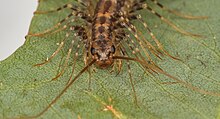Scutigeromorpha
| Scutigeromorpha | |
|---|---|

| |
| Close-up of a common scutigeromorph | |
| Scientific classification | |
| Domain: | Eukaryota |
| Kingdom: | Animalia |
| Phylum: | Arthropoda |
| Subphylum: | Myriapoda |
| Class: | Chilopoda |
| Subclass: | Notostigmophora |
| Order: | Scutigeromorpha |
| Families | |
Scutigeromorpha is an order of centipedes also known as house centipedes.[1] These centipedes are found in the temperate and tropical parts of every continent except Antarctica, with their distribution significantly expanded by the introduction of the Mediterranean species Scutigera coleoptrata throughout Europe, Asia, and North America.[2][3] The common species S. coleoptrata is a typical representative of this order, lying in wait for other arthropods, then seizing prey using great speed, and all species in this order reflect adaptations for this mode of life.[4]
Description
House centipedes are
The trunk of these centipedes features eight tergites:[2] The first trunk segment corresponds to a short first tergite, then seven large tergites follow. The first large tergite covers the second trunk segment, but the second covers segments 3 and 4, the third covers segments 5 and 6, the fourth covers segments 7, 8, and 9, and the remaining three each cover two segments per tergite.[4]
An especially striking feature that distinguishes this order from all other centipedes is the arrangement of
Fossil record
The earliest known fossil centipedes have been identified as belonging to the order Scutigeromorpha based on the morphology of their legs and their maxillipeds.[11] These Paleozoic fossils date the crown group of Chilopoda to at least the late Silurian, 418 million years ago.[12] These fossils place scutigeromorphs among the earliest terrestrial arthropods.[6] These older fossils differ enough from extant species to be assigned to the scutigeromorph stem group, but younger fossils may be similar enough to extant species to date the crown group of Scutigeromorpha to at least the Early Cretaceous.[12]
Families
There are 88 species and 27 genera of Scutigeromorph centipedes distributed among three families: Pselliodidae, Scutigeridae, and Scutigerinidae.[1] The small family Pselliodidae contains several species[13] and includes the genus Sphendononema, found in the Neotropics and tropical Africa.[2] The smallest family, Scutigerinidae, contains only a few species and includes the genera Scutigerina and Madagassophora,[14] found in South Africa and Madagascar.[2] Most scutigeromorph species belong to the largest family, Scutigeridae, with a cosmopolitan distribution.[6] The family Scutigeridae includes two subfamilies: Scutigerinae and Thereuoneminae.[15]
References
- ^ a b "ITIS - Report: Scutigeromorpha". itis.gov. Retrieved 2022-12-30.
- ^ ISBN 978-90-04-18826-6, retrieved 2024-02-29
- ^ Ricks, Winston. "Scutigera coleoptrata". Animal Diversity Web. Retrieved 2024-03-01.
- ^ ISBN 978-3-662-10396-8.
- S2CID 21401688.
- ^ ISSN 2079-0139.
- ^ .
- ^ "ITIS - Report: Notostigmophora". itis.gov. Retrieved 2024-02-29.
- ISSN 1175-5334.
- ^ "ITIS - Report: Pleurostigmophora". itis.gov. Retrieved 2024-02-29.
- ^ "Scutigeromorpha - an overview | ScienceDirect Topics". www.sciencedirect.com. Retrieved 2022-12-30.
- ^ ISSN 1467-8039.
- ^ "ITIS - Report: Pselliodidae". www.itis.gov. Retrieved 2024-02-29.
- ^ "ITIS - Report: Scutigerinidae". www.itis.gov. Retrieved 2024-02-29.
- ^ "ITIS - Report: Scutigeridae". itis.gov. Retrieved 2024-03-01.
